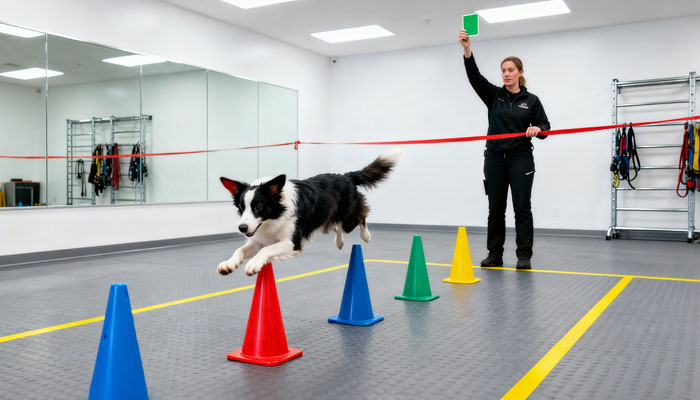Dog Training: The Four Biggest Pitfalls
Pitfall 1: Making Dogs Learn Too Frequently in Dog Training
When dogs first start dog training, most owners feel the progress is slow. They often rush to teach their dogs more commands, wishing they could complete all the basic lessons in a single day.
This is incorrect. As the saying goes, “You can’t chew more than you can swallow.” Moreover, if mistakes occur during the learning process, correcting them becomes much harder, making the effort counterproductive.
[The Right Approach]
To achieve a well-trained dog through dog training, adhere strictly to training principles. Ensure your dog experiences a balanced mix of work and rest during sessions—this approach guarantees results. Trainers must demonstrate patience and perseverance throughout the process, avoiding harsh methods. Some dogs grasp their owner’s intentions slowly during training, while others possess an innate “rebellious” streak, requiring even greater patience from their owner.
If a dog struggles to learn certain commands during training, resorting to harsh actions like verbal abuse or physical punishment will only cause the dog to become fearful and anxious. Persistence is key in dog training; never give up halfway. Don’t expect every dog to be a “genius” during training. Many commands are learned through consistent repetition and habit formation. Therefore, training must be repeated multiple times until the dog masters the command correctly. Never abandon the process or make concessions prematurely.
Pitfall 2: Neglecting the Choice of Training Environment in Dog Training
When beginning dog training, choosing the right environment is crucial. A complex, noisy setting can distract your dog, causing it to look around and lose focus. This significantly reduces training effectiveness. This is highly detrimental to the dog’s successful completion of training.
[The Right Approach]
Once a dog develops bad habits due to environmental issues during training, it’s too late to regret it. You and your dog need a quiet, distraction-free environment for training, as the setting profoundly impacts training outcomes.
Dog training requires patience and a step-by-step approach. Keep each session brief, ideally no longer than 15 minutes. Immediately reward your dog with praise, affection, or a treat whenever it performs a command correctly. This reinforces positive associations with training.
Pitfall 3: Hitting Dogs with Hands or Other Objects in Dog Training
The most immediate negative impact of hitting dogs during training is the destruction of the bond between owner and dog. This damage creates a significant barrier to rebuilding a trusting relationship in future training sessions. If your dog makes mistakes during training, necessary reprimands and gentle corrections are appropriate—but these are fundamentally different from physical punishment.
This outdated form of discipline is less about training and more about retaliating against disobedience. Frustrated by training setbacks, many owners resort to old-fashioned punishments like swatting the dog’s rear. While scolding or hitting might teach your dog certain commands, training this way means you may never witness your dog’s confident gaze or experience the joy of seamless cooperation during training exercises.
[The Right Approach]
When training puppies, it’s essential to establish the concept that “punishment is used to correct inappropriate behavior.” Over the past few years, “punishment” has almost become a taboo in dog training. Many mistakenly believe that using punishment in dog training is cruel, or even an ineffective training tool. In reality, punishment can be highly effective when applied promptly and appropriately to prevent unwanted behaviors in puppies.
Traditional punishment often involved arbitrary, delayed responses based on the owner’s mood long after the mistake occurred—an approach unsuitable for modern dog training. Ironically, while societal attitudes have shifted away from traditional punishment methods in dog training, instances of animal abuse continue to rise. Resolving this contradiction requires reevaluating our ethical stance on “punishment” in dog training and understanding how to properly utilize this powerful training tool.
We often assume that morally upright individuals would never inflict pain on their dogs. While this principle sounds noble in theory, it proves impractical in real-world dog training. To overcome this bias, we must adjust our ethical framework in dog training. The guiding principle should be “do no harm to the dog,” rather than hypocritically insisting on “causing no pain to the dog.”
Pitfall 4: Rigidly Applying Learning Models in Dog Training
Dog training manuals may detail specific methods, but following them step-by-step doesn’t guarantee success. You might watch countless training videos, yet the same techniques won’t necessarily work for your dog. Every dog possesses unique traits and temperaments; one-size-fits-all approaches are ineffective.
[The Right Approach]
Dog training requires a flexible approach rather than rigid imitation. Though it may seem like a straightforward task, it is fundamentally a science demanding adaptability and keen observation. While learning from others’ successful training experiences is valuable, you must fully comprehend these methods and apply them flexibly to your own dog.
Dog owners should focus on learning the principles, understanding, and philosophy behind training, rather than blindly imitating others. The most effective approach is to tailor training methods to each dog’s unique traits.
The correct approach to dog training is to proceed step by step, building a solid foundation, and progressing from easy to difficult tasks. Remember to be patient and show your dog plenty of love during training. While those who use exclusively positive reinforcement are admirable, those who know how to apply punishment correctly to achieve training goals are even rarer. We hope you can avoid these four major pitfalls in dog training and raise an obedient dog.
admin
-
Sale!

Washable Pet Cooling Pad for Cats and Dogs
$10.99Original price was: $10.99.$9.99Current price is: $9.99. This product has multiple variants. The options may be chosen on the product page -
Sale!

Washable Cat Window Hammock Cooling Bed
$23.99Original price was: $23.99.$22.99Current price is: $22.99. -
Sale!

Tropical Amphibian Rainforest Tank, Lizard Cage
$38.99Original price was: $38.99.$36.99Current price is: $36.99. -
Sale!

Silent 4-in-1 Waterproof Charging Dog Hair Trimmer
$49.88Original price was: $49.88.$47.99Current price is: $47.99.
